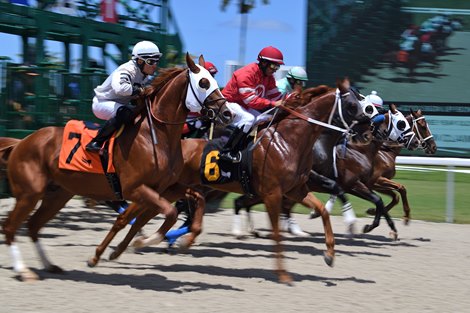Talking throughout a Sept. 10 panel at Churchill Downs, three monitor superintendents described a number of the challenges of sustaining artificial tracks and enhancements to their make-up and efficiency.
Jeff Chapman, monitor superintendent at Turfway Park, spoke in individual throughout Observe Superintendent Area Day and was joined remotely by Ryan Stafford, senior supervisor of racing surfaces at Woodbine, and Dennis Moore, a longtime monitor superintendent at a number of California tracks. Their remarks got here on the ultimate day of discussions throughout the three-day convention, which lured roughly 60 nonvendor attendees, about half of which had been monitor superintendents. The convention additionally included monitor executives, veterinarians, and business academic leaders.
The convention targeted on sharing finest practices to take care of numerous monitor surfaces and gear demonstrations.
In Tuesday’s artificial panel moderated by veterinarian Dr. Will Farmer, equine medical director for Churchill Downs Inc., all three superintendents acknowledged developments within the artificial surfaces since their growth in North America roughly 20 years in the past. Such surfaces should not maintenance-free or totally all-weather, as initially marketed.
Chapman stated Turfway transferring from grime to Polytrack in 2005 made a “world of distinction.” Nonetheless, it was not till the introduction of a track-maintenance device referred to as the cultivator got here into use that his employees was finest capable of keep the monitor. Turfway experiences a spread of various kinds of climate and precipitation when it runs throughout the winter.
“The cultivator was our savior,” he stated. “If we had that at first, we would have been so much higher off.”
Turfway Park now has a Tapeta Footings floor, changing Polytrack after utilizing it for 15 years. Woodbine switched earlier, going from Polytrack to Tapeta after 10 years in 2016. Tapeta is the market chief in North America.
Different tracks, corresponding to Keeneland and people in California, resumed racing on grime for numerous causes, starting from drainage points and underperformance in California to handicapping notion and the way artificial surfaces impacted graded stakes races in Kentucky.
Presque Isle Downs, like Turfway, races strictly on artificial, however of late, most tracks lately which have opted so as to add an artificial monitor have chosen to position one inside their grime and turf tracks. That’s the case at Gulfstream Park and is deliberate for Belmont Park, which can run over Tapeta throughout the winter months when the New York monitor reopens following rebuilding in 2026.
An artificial floor can also be into account for Saratoga Race Course, which after two summers of moist climate, has seen many off-the-turf races depleted of entrants when moved to the principle monitor. Most horsemen consider turf horses can switch their type to artificial higher than grime.
Horses are additionally statistically much less in danger for a deadly harm when racing on an artificial monitor vs. grime or turf.
Santa Anita Park additionally has an artificial coaching monitor, one its operators hope can be utilized in periods of inclement climate. Rain, extra frequent within the winter in comparison with different instances of the yr, now forces the monitor to cancel racing beneath the California Horse Racing Board’s strict inclement climate coverage. To maneuver ahead, that choice nonetheless wants trial-race testing and CHRB approval.
Moore, who oversaw the 1987 set up at Remington Park of Equitrack, the primary artificial monitor in the USA, later labored with artificial tracks in California when their use was initially mandated by the CHRB in 2006 (for racing in 2008). All of the Southern California tracks nonetheless working have returned to grime racing since.
He presently maintains the Tapeta coaching monitor at Santa Anita and stated artificial tracks in Southern California require watering “to chill down. You are watering to maintain it from altering, to maintain it extra steady and constant.”
The wax that binds with the fibers, sand, rubber, and different supplies on an artificial floor will break down if the floor temperature is just too scorching.
Breakdowns of binding supplies, which may additionally occur from prolonged utilization, can result in fibers separating, creating kickback.
Turfway and Woodbine cope with extra rain and frozen precipitation, which is extra simply dealt with throughout instances when the monitor shouldn’t be racing.
Artificial tracks, after they drain correctly, can face up to rain and stay “quick” resulting from their vertical draining system however should not immune from blockages.
When Woodbine canceled racing Aug. 17, the preliminary date of its in style King’s Plate program, roughly 5 inches of rain that fell within the early afternoon hours proved an excessive amount of for the monitor to deal with.
Woodbine had “couple spots not draining as quick as they need to have,” resulting in further buildup and a bit on the backstretch the place the Tapeta had develop into compacted, Stafford stated.
The artificial dialogue adopted an earlier session led by Greg Stiles, the Horseracing Integrity and Security Authority’s racetrack accreditation supervisor, relating to procedures and necessities for a racetrack to develop into accredited.
Observe floor consultants Jim Pendergest, Glen Kozak, and Jamie Richardson had been amongst those that spoke the day past.
Observe Superintendent Area Day, which rotates across the nation, will likely be held in 2025 at Hollywood On line casino at Penn Nationwide Race Course in Grantville, Pa.






